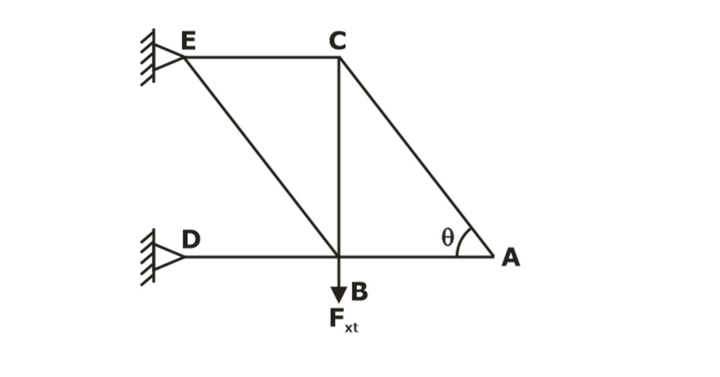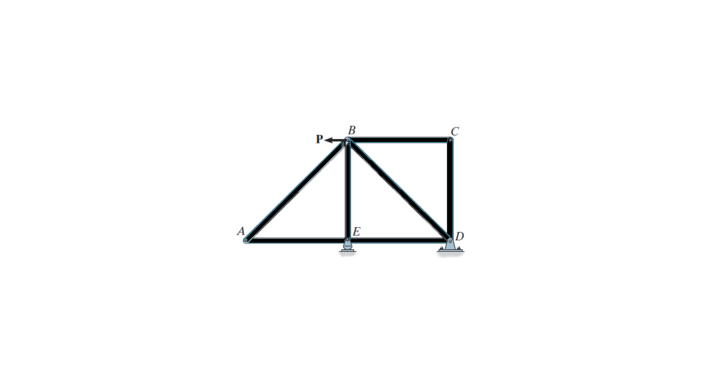Zero Force Member in a Truss
By BYJU'S Exam Prep
Updated on: September 25th, 2023

In Civil Engineering, many structures are designed based on their requirements; they may be a beam, columns, bridges, trusses, etc. Beams are designed mainly for transverse loads, and columns are designed to withstand compressive loads. Trusses are structures mainly designed to withstand the axial load, either compressive or tensile. There is some zero force member in a truss to maintain the whole stability of a truss. During the design, zero force member in a truss is used due to its requirement in exceptional conditions like the failure of an active member, changing the nature of the load, etc.
Zero Force Member in a Truss PDF
All members of the truss can resist only axial loads; all members of a truss are connected through the smooth pins, which can rotate freely about their point. So truss does not allow it to resist the bending moment. A zero force member in a truss is a member that has zero force in its normal condition, but in some exceptional situations, a zero force member in a truss can take axial loads. A zero force member in a truss can save the whole structure during the sudden failure of a member, and in such a way, it gives a prior warning of failure.
Table of content
What is Zero Force Member in a Truss?
In a truss, zero force members are the members who have zero force for the given condition of loading over the structure. These are the structural members that give zero support to the external loading. Still, they can withstand the external load when loading conditions change, or any active member of the truss becomes inactive. Providing a zero force member in a truss has many advantages.
A zero force member in a truss is a redundant member for a particular type of loading and structural conditions. When the structural conditions like loading will change, or any existing member of the truss becomes useless, in such conditions, the existing zero force member in a truss can take the external loads.
Download Formulas for GATE Civil Engineering – Environmental Engineering
How to Find Zero Force Members in a Truss?
A zero force member in a truss is a member who does not have any force in this. Two rules may be used to find zero-force members in a truss. They are as follows:
Case 1: At a two-member joint that is not parallel and there are no other external loads or reactions at the joint, both members are zero force members.
Case 2: At a three-member joint, if two of those members are parallel and there are no other external loads (or reactions) at the joint, then the member that is not parallel is a zero-force member.
Example of Case 1:

Using case 1
FAC = 0
FAB = 0
Proof of Case 1
ΣFy = 0
⇒ FAC sinθ = 0
Since sinθ can not be zero
⇒ FAC = 0
ΣFx = 0
FAB +FAC cosθ = 0
⇒ FAB = 0
Example of case 2:

Using case 2: FBD = 0
Proof of case 2
ΣFy = 0
⇒ FBD sinθ = 0
Since sinθ can not be zero
∴ FBD = 0
Condition For a Zero Force Member in a Truss
With the help of the above-mentioned rules, a zero force member in a truss can be easily identified. These are the members who provide extra stability to the existing condition of the structure. Above mentioned rules for finding a zero force member in a truss are based on certain geometrical and loading conditions, which are explained below:
- If at any joint in the structure, only two non-colinear members are present. There should not be any external force acting on the joint; In such case, these non-colinear members will be the zero force members.
- If at any joint in the structure, two colinear members and only one non-colinear member is present, there should not be any external force acting on the joint; In such case, this non-colinear member is a zero force member. This condition can be extended when an external force like support reaction or any other external force is acting at any support and one member passes through the joint in the same direction as that of external force; then, in such condition, any non-colinear member at the joint will be the zero force member.
- A member between two hinge support will be the zero force member.
Download Formulas for GATE Civil Engineering – Fluid Mechanics
Example of Zero Force Member in a Truss
Till now, we have understood how to identify the zero force member in a truss; These are the members in a truss structure which is earlier not required to withstand external loads, but when a member gets damaged, in such condition, these members will distribute the external loads and helps to maintain the overall stability of the structure. Let’s solve an example to get more idea about the zero force member in a truss that helps to enhance the related concepts.
Example: Find the zero force member in the given truss structure

Solution: In the given truss,
At joint ‘A’, There are only two noncolinear members AB and AE, present; So, according to case 1, These members are the zero force members.
At joint ‘C’, There are only two noncolinear members, CB and CD, present; So, according to case 1, These members are the zero force members.
Member DE is connected between two hinge support, so it will also be a zero force member.
Note: If joint E would be supported by roller support, then in such case, member DE will also be a zero force member because roller support gives a vertical reaction in the direction of member BE and member DE will become a non-colinear member at the joint, So, it will be zero force member.
Uses of Zero Force Member in a Truss
As we know, a zero force member in a truss is a member having no force. It will take loads only when an active member of the truss fails. Zero force member in a truss increases the overall rigidity and stability of the structure.
Zero-force members in a truss are used to withstand external loads when loading conditions are changed. Zero force members keep the structure in the same conditions even when loading patterns are changed, or any existing member gets damaged.


